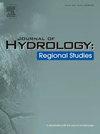伊朗网格化降水数据集的评价
IF 5
2区 地球科学
Q1 WATER RESOURCES
引用次数: 0
摘要
伊朗有6个气候区:1区(湿润的里海地区)、2区(寒冷半干旱的伊朗西北部)、3区(温和半湿润的伊朗西部)、4区(温和半干旱的伊朗东北部)、5区(温暖半干旱的伊朗西南部)和6区(温暖干旱的伊朗东部、南部和东南部)。本研究评估了七个网格降水数据集(CRU TS, TMPA 3B43, GPCC, IMERG, MERRA-2, ERA5和PDIR)与雨量计数据的性能。评估了这些数据集在2000年至2017年期间代表降水模式的准确性,重点关注了它们在伊朗不同气候带中的表现。在1区,ERA5在冬季和秋季表现最好,而GPCC在春季和夏季表现最好。在2区和3区,GPCC在大多数季节表现最好,而CRU TS在2区秋冬表现最好。在第4区,GPCC全年的表现优于所有数据集。在5区,TMPA 3B43在冬季表现最好,GPCC在其他季节表现略好。总体而言,ERA5在区域1中最准确,而GPCC在其他区域表现最好,PDIR在所有区域的表现都不佳。GPCC很好地捕捉了年际降水变化,使其整体表现最佳。我们推荐ERA5用于一区的实时监测,而GPCC更适合在雨量计网络密集的地区进行长期研究。本文章由计算机程序翻译,如有差异,请以英文原文为准。
Evaluation of gridded precipitation datasets over Iran
Study region
Six climate zones in Iran: Zone 1 (humid Caspian region), Zone 2 (cold and semi-arid northwestern Iran), Zone 3 (mild and semi-humid western Iran), Zone 4 (mild and semi-arid northeastern Iran), Zone 5 (warm and semi-arid southwestern Iran), and Zone 6 (warm and arid eastern, southern, and southeastern Iran).
Study focus
This study evaluates the performance of seven gridded precipitation datasets (CRU TS, TMPA 3B43, GPCC, IMERG, MERRA-2, ERA5, and PDIR) against rain gauge data. The accuracy of these datasets in representing precipitation patterns is assessed from 2000 to 2017, with a focus on their performance across diverse climate zones in Iran.
New insights for the region
In Zone 1, ERA5 performs best in winter and autumn, while GPCC excels in spring and summer. In Zones 2 and 3, GPCC is the top performer in most seasons, while CRU TS performs best in autumn and winter for Zone 2. In Zone 4, GPCC outperforms all datasets year-round. In Zone 5, TMPA 3B43 performs best in winter, with GPCC slightly outperforming others in other seasons. Overall, ERA5 is most accurate in Zone 1, while GPCC performs best in other zones, with PDIR consistently underperforming across all zones. GPCC captures interannual precipitation variability well, making it the best overall performer. We recommend ERA5 for real-time monitoring in Zone 1, while GPCC is better suited for long-term studies in areas with dense rain gauge networks.
求助全文
通过发布文献求助,成功后即可免费获取论文全文。
去求助
来源期刊

Journal of Hydrology-Regional Studies
Earth and Planetary Sciences-Earth and Planetary Sciences (miscellaneous)
CiteScore
6.70
自引率
8.50%
发文量
284
审稿时长
60 days
期刊介绍:
Journal of Hydrology: Regional Studies publishes original research papers enhancing the science of hydrology and aiming at region-specific problems, past and future conditions, analysis, review and solutions. The journal particularly welcomes research papers that deliver new insights into region-specific hydrological processes and responses to changing conditions, as well as contributions that incorporate interdisciplinarity and translational science.
 求助内容:
求助内容: 应助结果提醒方式:
应助结果提醒方式:


